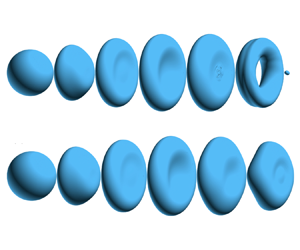No CrossRef data available.
Article contents
Impact of vaporization on drop aerobreakup
Published online by Cambridge University Press: 25 November 2024
Abstract

Aerodynamic breakup of vaporizing drops is commonly seen in many spray applications. While it is well known that vaporization can modulate interfacial instabilities, the impact of vaporization on drop aerobreakup is poorly understood. Detailed interface-resolved simulations were performed to systematically study the effect of vaporization, characterized by the Stefan number, on the drop breakup and acceleration for different Weber numbers and density ratios. It is observed that the resulting asymmetric vaporization rates and strengths of Stefan flow on the windward and leeward sides of the drop hinder bag development and prevent drop breakup. The critical Weber number thus generally increases with the Stefan number. The modulation of the boundary layer also contributes to a significant increase of drag coefficient. Numerical experiments were performed to affirm that the drop volume reduction plays a negligible role and the Stefan flow is the dominant reason for the breakup suppression and drag enhancement observed.
- Type
- JFM Papers
- Information
- Copyright
- © The Author(s), 2024. Published by Cambridge University Press



